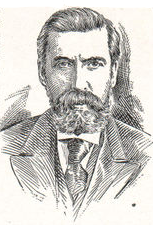vivors after great suffering reached England. All these voyages were made in the service of Dutch merchants. See George Asher's Henry Hudson the Navigator.
Hudson, N. Y., a city, port of entry, county-seat of Columbia County, on the Hudson River, about 30 miles from Albany. It is in an agricultural region, and has the following manufacturing establishments: Sash and blind factories and foundries and it makes machinery, car wheels, knit goods, and creamery products. The notable buildings are the State House of Refuge for Women, the State Volunteer Firemen's Home, the hospital, the orphanage, etc. The city owns and operates the waterworks. Claverack Landing was settled in 1783, became Hudson in 1784, was incorporated in 1785, and was made a port of entry in 1790. It has the service of two railroads. Population 11,417.
Hudson River, a river in New York state and one of the most beautiful in America. It rises in the Adirondack Mountains, 4,326 feet above sea level. At Glens Falls it drops 50 feet, then, taking a southerly direction, flows into the bay of New York. There is tidal influence for 151 miles from its mouth to Troy, and it is navigated by large steamboats to Albany. About 60 miles from New York city the river enters the highlands, the scene of Arnold's treason and André's death, towering abruptly from the water to a height of 1,600 feet. A few miles below are the United States Military Academy at West Point and the ruins of Fort Putnam. On leaving the highlands, the river widens to four and one half miles for 13 miles of its course, and is called Tappan Bay. Below, on the right, is a wall of rock, called the Palisades, from 300 to 500 feet in height, extending nearly 20 miles as far down as the upper part of New York city. From this point the river is called North River. The Hudson is 350 miles in length, and was named after Henry Hudson. Fulton's first steamboat was tried on its waters. A tunnel under the river between Jersey City and New York connects the latter with Greater New York. See the Panorama of the Hudson, published by the Bryant Literary Union of New York.
Hué (hōō-ā'), the capital of Anam, a French protectorate in Asia, is ten miles from the mouth of the Hue River. In 1801 it was strongly fortified by French officers. The heart of the city is occupied by the palace; much of the rest of it is filled with mud huts. There is little business. Population, with suburbs, 50,000.

Hughes, Charles Evans, governor of New York, was born at Glens Falls, N. Y., April 11, 1862. He was educated in the public schools of Newark, N. J., and graduated from Brown University in 1881. During the next two years he taught mathematics at Delaware Academy, Delhi, and attended Columbia Law School, graduating in 1884 and being prize-fellow from 1884 to 1887. He was admitted to the New York bar in June, 1884, and practiced in New York from 1884 to 1891. He was professor of law at Cornell Law School from 1893 to 1895 and in New York Law School from 1893 to 1902. He achieved national distinction as chief counsel for the Armstrong committee in its life-insurance investigation (1903–4). In 1905 he declined the nomination of the Republicans for mayor of New York. He was elected governor of New York in 1906, and again in 1908. He was made an honorary LL. D. in 1907 by Columbia University. He was strongly supported as candidate for the presidency before the Republican convention in 1908.
Hughes, James Laughlin, Canadian educator, was born on Feb. 20th, 1846, near Bowmanville, Ontario. He received a public school education, and began teaching at 18. In 1871 he became principal of the provincial model school at Toronto, and in 1874 he was appointed inspector of schools for Toronto, a position which he still holds. In 1883 the Ontario government sent him as its representative to St. Louis to investigate the kindergarten system of that city, and owing largely to his influence the kindergarten movement was started in Ontario. He has done much to improve methods of teaching and reading and encourage educational progress and reform in general. He is the author of Mistakes in Teaching, How to Secure Attention, Topical History of Canada and other publications, chiefly educational.

Hughes, Thomas, was born at Uffington, Berks, England, Oct. 20, 1823. He was educated at Rugby, entered Oxford in 1841, and was called to the bar in 1848, becoming a member of the chancery bar. In 1856 he published Tom Brown's School Days, a life-like and truthful picture of school days at Rugby. This is a book which will never die, and is
